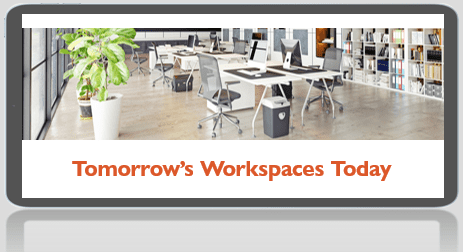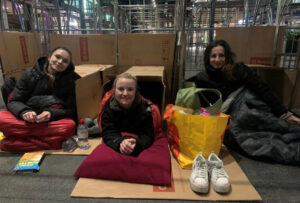6 trends to consider before refurbishing your office
The way our place of work looks, feels, and functions is tremendously important to how happy, healthy and effective we are, which of course influences the culture and success of an organisation.
If you are planning any sort of office refresh, there are no shortage of decisions to be made, many of which will be determined by factors such as budget, brand values and business objectives. If you have a particular goal in mind–such as fitting more staff within an existing space–or are just looking to inject some character back into your office, you may want to review these 6 up-and-coming office interior trends. There are some new and innovative ways to make the most of your workplace and potentially save you some cash along the way.
1. Agile workspaces
Many organisations have been working towards incorporating an agile work environment over recent years to embrace the culture and operational benefits that are recognised from adopting a more flexible approach.
A blockage to achieving such agility is in the traditional structure of the office. Static office structures, with desk-based offices, can kill off creativity by restricting employees to a single point of work. This layout discourages cross-department collaboration, project-based work, or any form of creativity that involves stepping away from an assigned desk.
Agile working empowers employees to get results by any means they see fit, offices now, therefore, need to be as dynamic and flexible as this new way of working.
We are seeing organisations make straightforward structural changes to their workplaces, which are helping them:
- Cope with ever-changing working requirements
- Adapt and cater to oscillating attendances/team sizes
- Enable effective collaboration working, even across departments
- Adjust for project-based work
However, achieving a workplace that meets all four of the above objectives can be challenging. Spaces need to avoid siloing teams and need to encourage employees to sit together and collaborate. For some spaces, straightforward structural change is necessary to facilitate this new way of working:
- Install raised-access flooring. This prevents employees from being restricted to specific areas of the room where networking cables and power outlets are installed.
- Use temporary office partitions. These can be used to create specific areas for specific projects and can be easily removed when no longer required.
- Create space for large TVs, whiteboards or wallboards in busy locations. This encourages collaboration and strengthens the overall strategic direction of a team, department or the company as a whole.
- Review the paths employees take to amenities. These paths can be constructed to encourage cross-collaboration between departments and encourage creativity.
All of the above can be achieved with minimal disruption to employees and, importantly, without a huge expenditure. Our Interiors team work closely with Tesco, helping them keep their offices refreshed at the weekend and after hours to minimise disruption.

2. Natural-looking lighting
Lighting is a sensitive subject among office workers. The British Council for Offices found that over half of all employees are dissatisfied with lighting conditions in their workplaces. A lack of natural light and gloomy lighting has been attributed to increased stress and greater absenteeism, so it really does make a difference.
The favoured option is to introduce more natural light into a building, but this is not always logistically possible. So, if installing additional skylights, more windows and transforming walls into transparent office partitions is not an option, you may want to consider the power of LED lights.
LED lights improve worker alertness, happiness and concentration, according to research by City University London. The most effective colour, according to the same study, is white with a bluish tint (1700K), which mimics natural blue tint of the sky but with white light to allow workers to focus.
The benefits of LEDs are not limited to employee happiness and productivity: there is a strong business case for their installation. Converting to LEDs can provide cost savings of up to 50% on monthly energy bills, are more environmentally friendly and reduce the need for reflectors and diffusers. If you think it’s time to upgrade your lighting, get in touch with our team to find the right solution for you.
3. The workplace for the circular economy
An increasing number of organisations are seeking to implement their core sustainability principles into their workplace design. To be green means more than simply having a recycling container on hand. The momentum towards a circular economy encourages organisations to ditch the ‘make, use, dispose’ model which has characterised our economy. Instead, businesses, consumers and manufacturers are being encouraged to play a role in recycling, waste minimisation and challenging the disposal mindset that many people have.
When refurbishing your workspace there is an opportunity to embrace the principles and practices of the circular economy. Prioritising what existing infrastructure or equipment can be reused, assessing options to lease outputs such as lighting, procuring for longevity.
An office refresh provides a great opportunity to find ways to fit within the circular economy:
- Speak to your contractor about reusing as much existing interior infrastructure as possible, ceiling tiles can be cleaned, partitions and doors altered for reuse etc.
- Identify items that are being disposed of, search for reuse options where viable either by donation (through a scheme such as The Giving Back Project) or resale
- Consider if your existing office furniture can be remanufactured or refurbished to meet future need – At our Renew Centre we can resize, restructure desks to meet future need and repair and reupholster chairs to ‘as good as new’ condition
- Donate redundant office furniture through initiatives such as The Giving Back Project
- Consider procuring quality refurbished office furniture over new, check out the quality of the stylish furniture at Office Resale.

4. Biophilic interiors
Biophilia, despite the very clinical name, describes the human love of nature. Naturally coloured spaces, plants and pseudo gardens are popping up in offices across the UK. Although the office plant has been a fixture in offices for a while, biophilic design is taking this to the next level, but this trend is not to be baulked at.
In 2014, university researchers in Cardiff published a research paper investigating the link between biophilic office designs and employee behaviour. The study concluded that employees who work in spaces with natural greenery are happier, healthier and more productive than colleagues in conventional office environments, even after three months.
Biophilic interiors help staff remain focused, keep calm and it’s all because of our biologically-ingrained associations with this colour. Shades of green, yellow and orange remind us of healthy vegetation, which we associate with nutrient-packed foods and clean water. We feel more comfortable and satisfied with these two intrinsic worries met, so we can focus on the matter at hand.
We are seeing everything from artificial turf furnishing offices and even more creative approaches – including golf course inspired meeting rooms with swing simulators. Fortunately, you don’t need a massive budget to benefit from introducing greenery into your workplace.
5. The functional office layout
No longer are offices fitted out with the same desk, chair and equipment combination throughout. We are now seeing spaces characterised by large, open-place layouts that encourage creative thinking and collaboration. However, this open setup does have some disadvantages – as it is not fit for every single task, all of the time.
Functional office layouts are better equipped for agile working, giving employees options to work in the conditions that match their needs. If they need to be deeply focused, then they may want to work in an isolated working area, whereas a more creative brief may encourage employees to take a step away from their regular surroundings.
We are seeing offices furnished with a variety of working options, each for different functions, including:
- Break-out areas which encourage employees to recuperate, regain their focus and work in a less formal environment.
- Quiet zones which create a heads-down, more focused working environment when required.
- Touchdown areas enable impromptu meetings and collaboration, without having to formally book a meeting room.
- Baron spaces can be filled with ‘nooks’ for reflective thinking, or quieter conversations.
The paths around these zones can also be created to encourage interaction between employees, responsible recycling and to create a greater sense of community amongst employees.
6. The SMART workplace
In the future we may have robots with artificial intelligence doing all of our admin work for us, 3D printers may be at our desk or we might not even travel to work with the advent of virtual office spaces. Whilst these three particular examples of tech in the office may be quite a way off, we are seeing a growing number of sensors entering our offices – and they are already making waves.
Lighting sensors detect human presence and can adjust their brightness depending on the availability of natural light. Temperature sensors feedback into the heating system to only activate heaters in rooms where people are going. Sensors even being used to detect air quality and odour.
These tiny sensors are helping businesses save money, become greener and keep employees more comfortable throughout the day. So in a way, the SMART office is already here!
Related stories
Sustainability remains a top business priority for Crown in the UK & Ireland and globally; we are therefore delighted to have launched our 2023 UKI Sustainability Report!
Crown are delighted to announce that we have been awarded Gold by EcoVadis in 2024 for the second time, reflecting our commitment to and progress in becoming a responsible business.
We supported both Landaid and the YMCA with cardboard boxes for their annual sleepout events. We were incredibly pleased to deliver 1,100 boxes as well as bring along a group of volunteers to the YMCA event.




















